Food Systems and Food Security: The Role of Small Farms and Small Food Businesses in Santiago Island, Cabo Verde
Abstract
1. Introduction
2. Materials and Methods
2.1. Study Area: Geography and Climatic Characterisation
2.2. Study Area: Socio-Economic and Agricultural Sector
2.3. Conceptual and Analytical Framework
2.4. Data Collection
2.5. Data Analysis
3. Results and Discussion
3.1. Identification of the Key Staple Products and Development of a Balance Sheet
- Fruits (Banana): The choice of banana is justified for being the fruit produced in greater quantity in the region, with greater regularity in supplying the markets during the whole year and for being an extremely important fruit in guaranteeing food security. The banana crop, along with papaya, has an average yield per hectare that is much higher than the other fruits combined, constituting an important source of income for the producers. Additionally, its production flow is continuous. The estimated current fruit production is between 10.000 and 12.000 tons per year, of which between 6.500 and 7.000 tons are bananas. In terms of consumption, banana is the fruit most consumed by children (80%), made preferably as snack, which is justified for being affordable to families and abundant fruit supplying the market all year round [69].
- Vegetables (Tomato): The choice of tomato as a main product was because it is the most produced vegetable in Santiago Island and available all year round, grown in open fields and greenhouses, and produces up to three harvests per year. The quantity produced is higher than the quantity imported. Most of the tomato consumed is produced locally, while imported tomatoes are mainly for tourist hotels. Data provided by [70,71,72] from 2016–2018 inform that the average availability between 2007 and 2016 was about 66.867 tons/year.
- Cereals (Maize): Despite its uncertainty of production and low productivity in Cabo Verde’s bioclimatic conditions, maize is an important crop in the country’s agricultural production system, since it is the only cereal produced in the country and one of the bases of the food diet, contributing significantly to the food security of rural households. It is produced only in rainfed farming (that is, without irrigation), being highly dependent on the precipitations that are scarce and irregular. Being an integral part of almost all the typical dishes in the Cabo Verdean gastronomy, maize production is a traditional and subsistence crop, mainly for self-consumption; it is not considered a market product. However, production levels are relatively insufficient for the desired level of consumption.
- Meat (Chicken): The choice of chicken was due to its level of consumption by the population, since its low price makes it more accessible to families. Moreover, its distribution using the cold chain is already well established in the country. From the household survey [45] per capita expenditure of national consumption of chicken meat is €16.8 compared to €10.5 for pork and €9.9 for beef, which gives us a good indication of the meat most consumed in the reference region.
3.2. Balance of Production and Consumption of Key Food Products in the Region
3.3. Food System: Key Nodes and Flows and Role of Small Farms and Small Food Businesses
3.3.1. Banana
3.3.2. Tomato
3.3.3. Maize
3.3.4. Chicken Meat
3.4. Governance and Other Factors Influencing Food Security
3.4.1. Agricultural Support and Policies
3.4.2. Production Efficiency
3.4.3. Level of Prices and Purchasing Power of Consumers
3.4.4. Market Organisation
4. Conclusions
Author Contributions
Funding
Acknowledgments
Conflicts of Interest
Appendix A
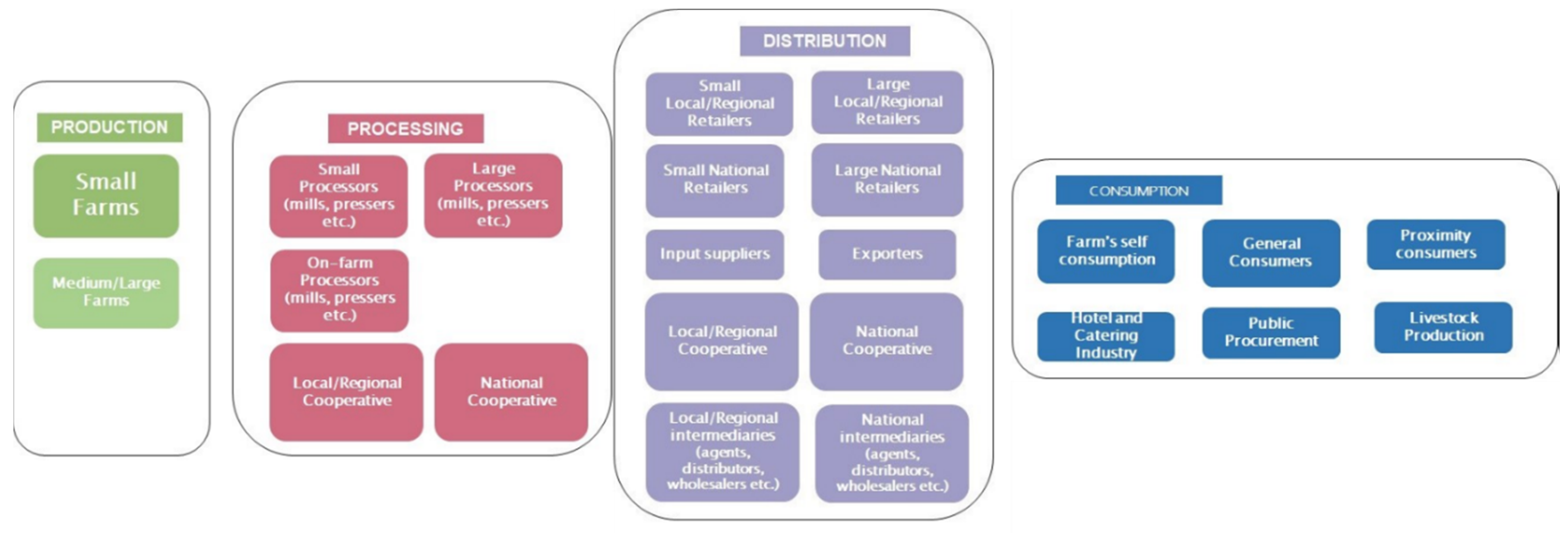
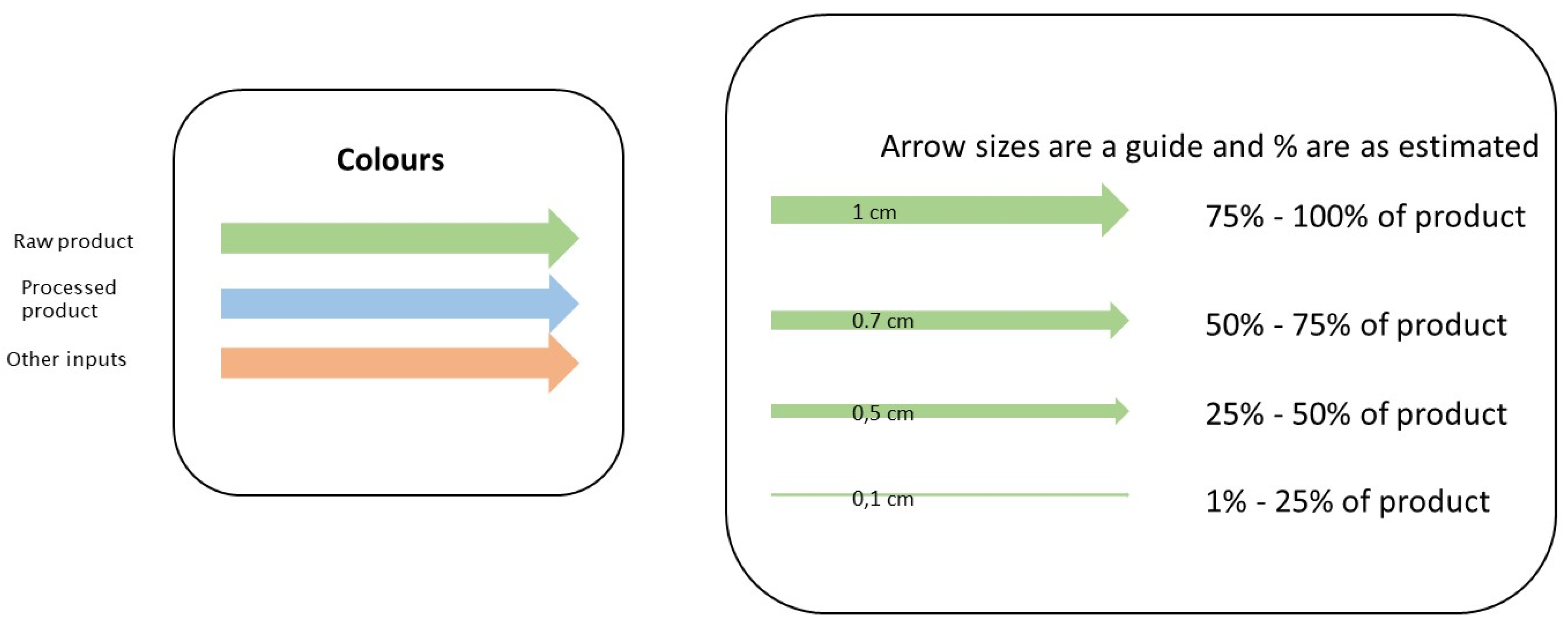
References
- FAO. Towards Stronger Family Farms: Voices in the International Year of Family Farming; Food and Agriculture Organization of the United Nations: Rome, Italy, 2014. [Google Scholar]
- Lowder, S.K.; Skoet, J.; Singh, S. What Do We Really Know about the Number and Distribution of Farms and Family Farms Worldwide? Background paper for the State of Food and Agriculture 2014; ESA Working Paper No. 14-02; Food and Agriculture Organization of the United Nations: Rome, Italy, 2014. [Google Scholar]
- Correia, A.M.N.G. A Agricultura Familiar Versus a Agricultura de Subsistência no Âmbito da Segurança Alimentar no Espaço dos Países da CPLP. In Carvalho, Segurança Alimentar e Nutricional na Comunidade dos Países de Língua Portuguesa: Desafios e Perspectivas; Em, S.C., Lima, R., Magalhães, L.E., Fonseca, A., Eds.; Fundação Fio-Cruz, Instituto de Higiene e Medicina Tropical: Rio de Janeiro, Brazil, 2012; pp. 119–133. [Google Scholar]
- Moyo, S. Family Farming in Sub-Saharan Africa: Its Contribution to Agriculture, Food Security and Rural Development; Working paper number 150; International Policy Centre for Inclusive Growth: Brasilia, Brazil, 2016. [Google Scholar]
- Hazell, P.; Poulton, C.; Wiggins, S.; Dorward, A. The Future of Small Farms for Poverty Reduction and Growth; International Food Policy Research Institute: Washington, DC, USA, 2007. [Google Scholar]
- Lele, U.; Agarwal, M. Smallholder and Large Scale Agriculture in Africa: Are There Tradeoffs between Growth and Equity? Managing agricultural development in Africa (MADIA) discussion paper; no. 6; The World Bank: Washington, DC, USA, 1989; Available online: http://documents.worldbank.org/curated/en/401471468768036333/pdf/multi-page.pdf (accessed on 2 February 2020).
- Bakker, H. Food Security in Africa and Asia: Strategies for Small-Scale Agricultural Development; Cabi: Oxfordshire, UK, 2011. [Google Scholar]
- Carvalho, B.R.P. Food Sovereignty, Food Security and Sustainable Development: Environmental and Economic Challenges. In Problems of Agricultural Economics; No. 2; Institute of Agricultural and Food Economics, National Research Institute: Warszawa, Poland, 2016; Available online: https://ssrn.com/abstract=2850902 (accessed on 8 December 2019).
- Woodhill, J.; Hasnain, S.; Griffith, A. Farmers and Food Systems: What Future for Smallscale Agriculture? Environmental Change Institute, University of Oxford: Oxford, UK, 2020. [Google Scholar]
- Pernechele, V.; Balié, J.; Ghins, L. Agricultural Policy Incentives in Sub-Saharan Africa in the Last Decade (2005–2016); Food and Agriculture Organization of the United Nations: Rome, Italy, 2018. [Google Scholar]
- OECD; FAO. OECD-FAO Agricultural Outlook 2016–2025; Organisation for Economic Co-operation and Development, OECD Publishing: Paris, France; Food and Agriculture Organization of the United Nations: Rome, Italy, 2016; Available online: http://dx.doi.org/10.1787/agr_outlook-2016-en (accessed on 15 December 2019).
- African Union; New Partnership for Africa’s Development. Comprehensive Africa Agriculture Development Programme (CAADP); NEPAD: Midrand, South Africa, 2003. [Google Scholar]
- Simon, G.A. Concepto y gobernanza internacional de la seguridad alimentaria: De dónde venimos y hacia dónde vamos. In Revista Española de Estudios Agrosociales y Pesqueros 224: 4; Ministerio de Medio Ambiente y Medio Rural y Marino: Madrid, Spain, 2009. [Google Scholar]
- Silva, J.H.C. Importância da Horticultura Para a Segurança Alimentar em Cabo Verde—Estudo de Caso na Ilha do Fogo; Universidade Técnica de Lisboa, Instituto Superior de Agronomia: Lisboa, Portugal, 2009. [Google Scholar]
- Monteiro, M.F.F. Segurança Alimentar em Cabo Verde. Estudo de Caso no Concelho de Ribeira Grande, Ilha de Santo Antão; Universidade Técnica de Lisboa, Instituto Superior de Agronomia: Lisboa, Portugal, 2012. [Google Scholar]
- Reis, V. Fontes de Rendimento das Famílias Rurais e a Segurança Alimentar em Cabo Verde. Cad. Estud. Afr. 2015. [Google Scholar] [CrossRef]
- Triches, R.M.; Schneider, S.; Simões, E. Aquisições públicas em Cabo Verde: Desafios e potencialidades para promover o desenvolvimento rural. Rev. Angolana Sociol. 2013, 11, 63–80. [Google Scholar] [CrossRef]
- Ferreira, V.A.D.S.; Simoes, E. Agricultura e mercados institucionais em cabo verde. avaliação e seguimento do programa-piloto compras locais. In Abastecimento Alimentar: Redes Alternativas e Mercados Institucionais, 1st ed.; Perez-Cassarino, J., Marcia Triches, R., Giacomo Baccarin, J., Rosane Paz, C., Teo, A., Eds.; UFFS e UNICV: Praia, Cabo Verde, 2018; Volume 1, pp. 113–128. [Google Scholar]
- Simões, E.B.; Ferreira, V.A.D.S.; Basch, G. Segurança Alimentar em Cabo Verde. Segurança Aliment. Nutr. 2019, 27. [Google Scholar] [CrossRef]
- Ferreira, A.J.D.; Baptista, I.; Tavares, J. A Luta Contra a Desertificação em Cabo Verde. Riscos Naturais Antrópicos e Mistos; Rebelo, F., Ed.; Departamento de Geografia, Faculdade de Letras da Universidade de Coimbra: Coimbra, Portugal, 2013; pp. 697–712. [Google Scholar]
- Santos, L.S.D. Ações de Gestão Ambiental na Mitigação da Desertificação em Cabo Verde–Análise de Técnicas de Conservação do Solo e Água; Instituto Politécnico de Coimbra, Escola Superior Agrária de Coimbra: Coimbra, Portugal, 2016. [Google Scholar]
- Cruz, O. Sistemas Agrícolas e Recursos Humanos em vista a Segurança Alimentar em Cabo Verde. In 1as Jornadas Sobre Agricultura de Cabo Verde; Instituto de Investigação Científica Tropical: Lisboa, Portugal, 1992; pp. 269–276. [Google Scholar]
- Teixeira, A.J.S.; Barbosa, L.A.G. A Agricultura do Arquipélago de Cabo Verde (Cartas agrícolas. Problemas agrários). Memórias J. I U 1958, 2, 178. [Google Scholar]
- Diniz, A.C.; Matos, G.C. Carta de Zonagem Agro-Ecológica e da Vegetação de Cabo Verde. I—Ilha de Santiago. Garcia Orta Sér. Bot. 1986, 8, 39–82. [Google Scholar]
- Mota Gomes, A. Hidrogeologia e Recursos Hídricos da Ilha de Santiago (Cabo Verde); Universidade de Aveiro: Aveiro, Portugal, 2007; p. 296. [Google Scholar]
- Ferrão, J.E.M.O. Regadio como processo de aumento da produção de alimentos nos PVD. In 3as Jornadas de Engenharia dos Países de Língua Oficial Portuguesa; Instituto de Investigação Científica Tropical, Ministério da Ciência e da Tecnologia: Lisboa, Portugal, 1998; pp. 81–89. [Google Scholar]
- INE. Anuário Estatístico Cabo Verde 2016; Instituto Nacional de Estatística: Praia, Cabo Verde, 2017. [Google Scholar]
- INE. Recenseamento Geral da População e da Habitação, Censos 2010; Instituto Nacional de Estatística: Praia, Cabo Verde, 2011. [Google Scholar]
- INE. Anuário Estatístico Cabo Verde 2015; Instituto Nacional de Estatística: Praia, Cabo Verde, 2015. [Google Scholar]
- Rocha, M.I.M.; Gomes, M.A.A.; Veiga, R. Atelier—Iniciativa Global—Consumo de Frutas e Legumes Para Uma Melhor Saúde; Fundo Das Nações Unidas para Alimentação e Agricultura, Ministério do Desenvolvimento Rural, Ministério da Saúde, Organização Mundial da Saúde: Praia, Cabo Verde, 2015. [Google Scholar]
- MAA. Recenseamento Geral da Agricultura 2015; Dados Gerais; Ministério do Agricultura e Ambiente: Praia, Cabo Verde, 2017.
- MAAP. Recenseamento Geral da Agricultura. Dados Gerais; Ministério do Ambiente, Agricultura e Pescas: Praia, Cabo Verde, 2004.
- Correia e Silva, A. Histórias de um Sahel Insular; Spleen-Edições: Praia, Cabo Verde, 1996. [Google Scholar]
- ACTUAR. A Agricultura Familiar na CPLP: Contribuições da REDSAN-CPLP e da PC-CPLP.; Associação para a Cooperação e o Desenvolvimento: Lisboa, Portugal, 2014. [Google Scholar]
- MAA. Programa Nacional de Segurança Alimentar 2007–2011; Ministério do Agricultura e Ambiente: Praia, Cabo Verde, 2006.
- Cardoso, M. Cabo Verde e S. Tomé e Príncipe. Educação e Infraestruturas Como Factores de Desenvolvimento; Edições Afrontamento, Colecção Biblioteca das Ciências Sociais/Plural: Porto, Portugal, 2007. [Google Scholar]
- Monteiro, F.; Fortes, A.; Ferreira, V.; Pereira Essoh, A.; Gomes, I.; Correia, A.M.; Romeiras, M.M. Current Status and Trends in Cabo Verde Agriculture. Agronomy 2020, 10, 74. [Google Scholar] [CrossRef]
- MDR. Estratégia Nacional De Segurança Alimentar E Nutricional Atualização Horizonte 2020; Ministério do Desenvolvimento Rural: Praia, Cabo Verde, 2014.
- INE. Contas Nacionais—2007 a 2017; Instituto Nacional de Estatística: Praia, Cabo Verde, 2019. [Google Scholar]
- MEAP; FAO. Agriculture et Peche: Strategie de Development a L’Horizon 2015 & Plan D’Action 2005–2008; Ministère de l’Environnement, de l’Agriculture et de la Pêche, Food and Agriculture Organization: Praia, Cabo Verde, 2004.
- Governo de Cabo Verde. Programa do Governo Para a VII Legislatura: 2006–2011; República de Cabo Verde: Praia, Cabo Verde, 2006. [Google Scholar]
- Governo de Cabo Verde. Programa do Governo Para a VIII Legislatura. 2011–2016; República de Cabo Verde: Praia, Cabo Verde, 2011. [Google Scholar]
- MFP. Documento de Estratégia de Crescimento e Redução da Pobreza III; Ministério das Finanças e do Planeamento: Praia, Cabo Verde, 2012. [Google Scholar]
- MF. PEDS—Plano Estratégico de Desenvolvimento Sustentável 2017/2021; Ministério das Finanças, Direção Nacional do Planeamento: Praia, Cabo Verde, 2018. [Google Scholar]
- INE. Cabo Verde—Inquérito às Despesas e Receitas Familiares (IDRF), Condições de Vida; Instituto Nacional de Estatística: Praia, Cabo Verde, 2015. [Google Scholar]
- SETAGRI. Carta de Ocupação Dos Solos na Escala de 1/25.000; Ministério do Desenvolvimento Rural/SCET AGRI (Santiago—Folhas Leste e Oeste): Praia, Cabo Verde, 1981.
- ANSA. Anuário de Segurança Alimentar de Cabo Verde 2010–2011; Agência Nacional de Segurança Alimentar: Praia, Cabo Verde, 2013. [Google Scholar]
- Carvalho, B.R.P. A Segurança Alimentar e o Desenvolvimento Rural: Africa Sub-Shariana. In Série de Estudos de Desenvolvimento e Gestão de Sistemas 8 (1); Secção De Agronomia Tropical e Subtropical, Instituto Superior de Agronomia: Lisboa, Portugal, 2002. [Google Scholar]
- Ferrão, J.E.M. Conceitos de Segurança Alimentar. Consequências Nos Países Mais Pobres. Gaz. das Aldeias 2002, 3094, 33–39. [Google Scholar]
- FAO. Food Security, FAO Policy Brief, 2. 2006. Available online: http://www.fao.org/forestry/13128-0e6f36f27e0091055bec28ebe830f46b3.pdf (accessed on 8 December 2019).
- Ericksen, P.J.; Ingram, J.S.I.; Liverman, D.M. Food security and global environmental change: Emerging challenges. Environ. Sci. Policy 2009, 12, 373–377. [Google Scholar] [CrossRef]
- Neto, J.F. Angola: Agriculturas e Alimentação; Instituto Português de Apoio ao Desenvolvimento: Lisboa, Portugal, 2008. [Google Scholar]
- Grando, S.; Galli, F.; Prosperi, P.; Brunori, G. “Small Farms and Food and Nutrition Security: An Empirically Grounded Conceptual Framework”. Small Farms, Small Food Businesses and Sustainable Food Security—SALSA. Project number: 677363 Collaborative project Horizon2020, WP1, Deliverable 1.1. Available online: www.salsa.uevora.pt (accessed on 2 December 2019).
- Davidova, S.; Fredriksson, L.; Gorton, M.; Mishev, P.; Petrovici, D. Subsistence Farming, Incomes, and Agricultural Livelihoods in the New Member States of the European Union. Environ. Plan. C Gov. Policy 2012, 30, 209–227. [Google Scholar] [CrossRef]
- Grando, S.; Brunori, G.; Pinto-Correia, T.; Sutherland, L.-A. Small Farming and the Food System. “Innovation for sustainability: Small farmers facing new challenges in the evolving food systems”. In Research in Rural Sociology and Deevelopment; Emerald Publishing: Bingley, UK, 2020. [Google Scholar]
- Palmioli, L.; Grando, S.; Di Iacovo, F.; Fastelli, L.; Galli, F.; Prosperi, P.; Rovai, M.; Brunori, G. Small farms’ strategies between self-provision and socio-economic integration: Effects on food system capacity to provide food and nutrition security. Local Environ. 2019. [Google Scholar] [CrossRef]
- Ericksen, P.J. Conceptualizing food systems for global environmental change research. Glob. Environ. Chang. 2008, 18, 234–245. [Google Scholar] [CrossRef]
- Ingram, J. A food systems approach to researching food security and its interactions with global environmental change. Food Secur. 2011, 3. [Google Scholar] [CrossRef]
- Dioula, B.M.; Deret, H.; Morel, J.; Vachat, E.; Kiaya, V. Enhancing the Role of Smallholder Farmers in Achieving Sustainable Food and Nutrition Security. In Proceedings of the ICN2 2nd International Conference on Nutrition “Better Nutrition, Better Lives”, Rome, Italy, 19–21 November 2014. [Google Scholar]
- Frelat, R.; Lopez-Ridaura, S.; Giller, K.E.; Herrero, M.; Douxchamps, S.; Djurfeldt, A.A.; Erenstein, O.; Henderson, B.; Kassie, M.; Paul, B.K.; et al. Drivers of household food availability in sub-Saharan Africa based on big data from small farms. Proc. Natl. Acad. Sci. USA 2015, 113, 458–463. [Google Scholar] [CrossRef] [PubMed]
- Riesgo, L.; Louhichi, K.; Gomez y Paloma, S.; Hazell, P.; Ricker-Gilbert, J.; Wiggins, S.; Sahn, D.E.; Mishra, A.K. Food and Nutrition Security and Role of Smallholder Farms: Challenges and Opportunities. In Institute for Prospective Technological Studies; Information for Meeting Africa’s Agricultural Transformation and Food Security Goals (IMAAFS); JCR Conference and Workshop Reports; European Commission Publications Office: Luxembourg, 2016. [Google Scholar]
- HLPE. Food Losses and Waste in the Context of Sustainable Food Systems; A report by the High Level Panel of Experts on Food Security and Nutrition; Committee on World Food Security: Rome, Italy, 2014. [Google Scholar]
- UNEP. Food Systems and Natural Resources; A Report of the Working Group on Food Systems of the International Resource Panel; Westhoek, H., Ingram, J., Van Berkum, S., Özay, L., Hajer, M., Eds.; United Nations Environment Programme: Nairobi, Kenya, 2016. [Google Scholar]
- Fournier, S.; Touzard, J.-M. La Complexité des Systèmes Alimentaires: Un Atout Pour la Sécurité Alimentaire? VertigO-la Revue Électronique en Sciences de L’environnement. 2014. Volume 14. Available online: https://journals.openedition.org/vertigo/14840 (accessed on 2 February 2020). [CrossRef]
- Trienekens, J.H. Agricultural Value Chains in Developing Countries A Framework for Analysis. Int. Food Agribus. Manag. Rev. 2011, 14, 51–82. Available online: https://ageconsearch.umn.edu/record/103987 (accessed on 2 February 2020).
- Ireland, R.D.; Webb, J.W. A multi-theoretic perspective on trust and power in strategic supply chains. J. Oper. Manag. 2007, 25, 482–497. [Google Scholar] [CrossRef]
- Cox, A.; Ireland, P.; Lonsdale, C.; Sanderson, J.; Watson, G. Supply Chains, Markets and Power, Mapping Buyer and Supplier Power Regimes; Routledge: New York, NY, USA, 2002. [Google Scholar]
- Brunori, G.; Grando, S.; Galli, F.; Fastelli, L.; Di Iacovo, F. Analytical Framework and Criteria for the Identification of Small Farms and for Their Differentiation. Small Farms, Small Food Businesses and Sustainable Food Security—SALSA. Project number: 677363 Collaborative project Horizon2020, WP1, Deliverable 1.2. 2017. Available online: www.salsa.uevora.pt (accessed on 8 December 2019).
- Silva, M.F.F. Hábitos de Consumo e Comportamento do Consumidor: Estudo de Caso da Ilha De Santiago; Instituto Superior de Agronomia da Universidade Técnica de Lisboa: Lisboa, Portugal, 2005. [Google Scholar]
- ARFA. Info Mensal, Boletim Mensal N 162; Agência de Regulação e Supervisão dos Produtos Farmacêuticos e Alimentares: Praia, Cabo Verde, 2016. [Google Scholar]
- ARFA. Relatório Do Mercado Internacional, Edição Especial N 7 Jan—Dez; Agência de Regulação e Supervisão dos Produtos Farmacêuticos e Alimentares: Praia, Cabo Verde, 2016. [Google Scholar]
- ARFA. Relatório Mensal Do Mercado Internacional, N 93; Agência de Regulação e Supervisão dos Produtos Farmacêuticos e Alimentares: Praia, Cabo Verde, 2018. [Google Scholar]
- DNRE. Dados de Importação, Produção, Consumo; Direcção das Alfândegas, Direção Nacional de Receitas do Estado, Ministério das Finanças: Praia, Cabo Verde, 2018.
- Couto, C. Incerteza, Adaptabilidade e Inovação na Sociedade Rural da Ilha de Santiago de Cabo Verde; Fundação Calouste Gulbenkian: Lisboa, Portugal, 2010. [Google Scholar]
- Santos, M.E.O. Problemas Entomológicos na Cultura do Tomate em Cabo Verde. Estudo de Caso na Ilha de Santiago; Instituto Superior de Agronomia da Universidade Técnica de Lisboa: Lisboa, Portugal, 2011. [Google Scholar]
- MDR. Novas Tecnologias Revolucionam Agricultura em Cabo Verde; Ministério do Desenvolvimento Rural: Praia, Cabo Verde, 2012.
- Mendes, A.A.F. Análise Comparativa da Rentabilidade de Algumas Culturas de Regadio na Ilha de Santiago em Cabo Verde; Instituto Superior Agronomia da Universidade Técnica de Lisboa: Lisboa, Portugal, 2009. [Google Scholar]
- INE. Inquérito às Despesas e Receitas Familiares (IDRF), Condições de Vida (2001–2002); Instituto Nacional de Estatística: Praia, Cabo Verde, 2004. [Google Scholar]
- MDR. Pecuária: Ontem, Hoje e Amanhã; Ministério do Desenvolvimento Rural: Praia, Cabo Verde, 2012.
- Tavares, E. Estudo do Impacto da Liberalização do Comércio Externo no Sector Avícola—Produção de Frangos; Instituto Nacional de Investigação e Desenvolvimento Agrário: São Jorge dos Órgãos, Cabo Verde, 2002. [Google Scholar]
- Dethier, J.-J.; Effenberger, A. Agriculture and development: A brief review of the literature. Econ. Syst. 2012, 36, 175–205. [Google Scholar] [CrossRef]
- Xu, X.; Jeffrey, S.R. Efficiency and Technical Progress in Traditional and Modern Agriculture: Evidence from Rice Production in China. Agric. Econ. 1998, 18, 157–165. [Google Scholar] [CrossRef]
- Bravo-Ureta, B.E.; Rieger, L. Dairy Farm Efficiency Measurement Using Stochastic Frontiers and Neoclassic Duality. Am. J. Agric. Econ. 1991, 73, 421–428. [Google Scholar] [CrossRef]

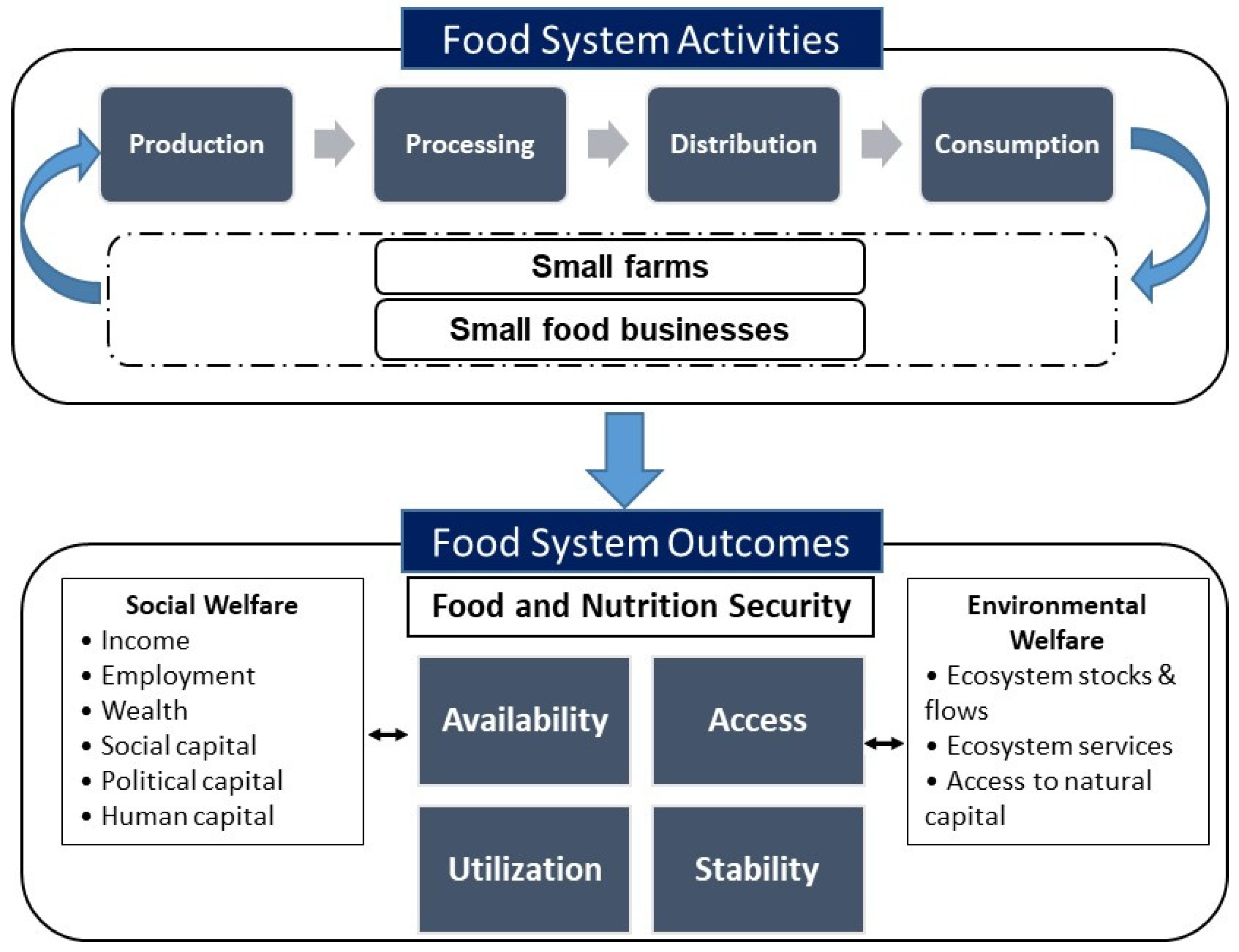
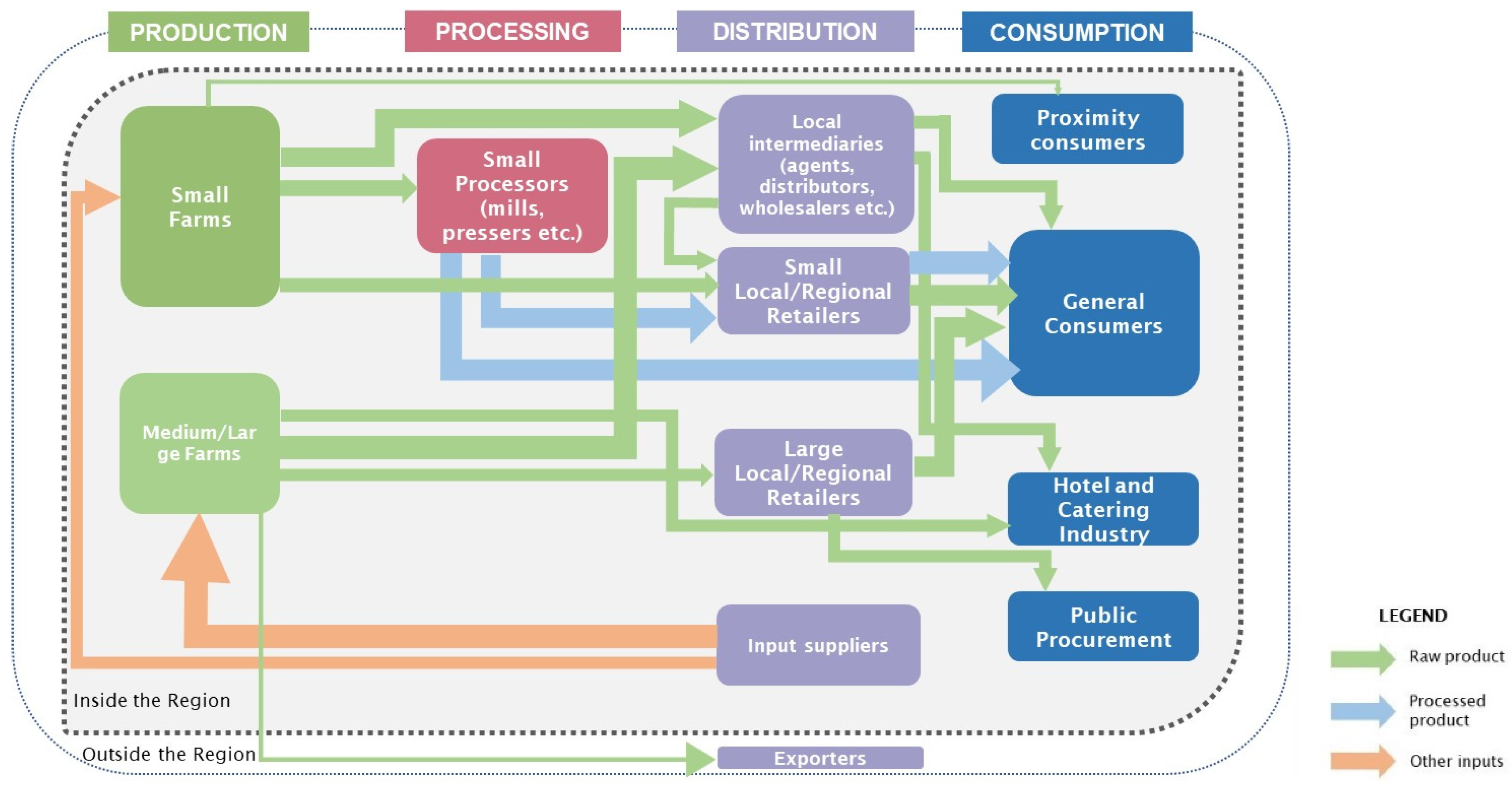
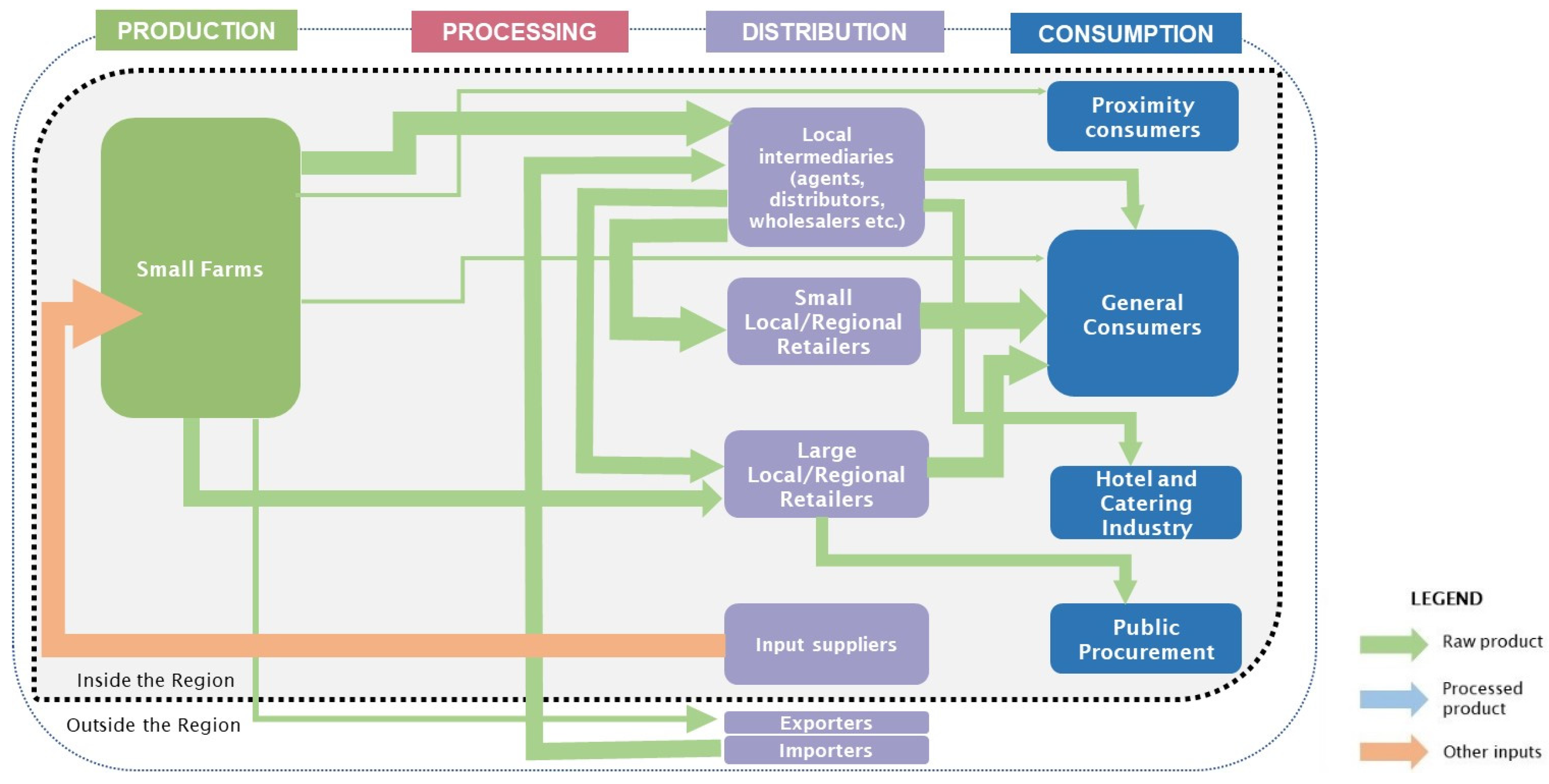
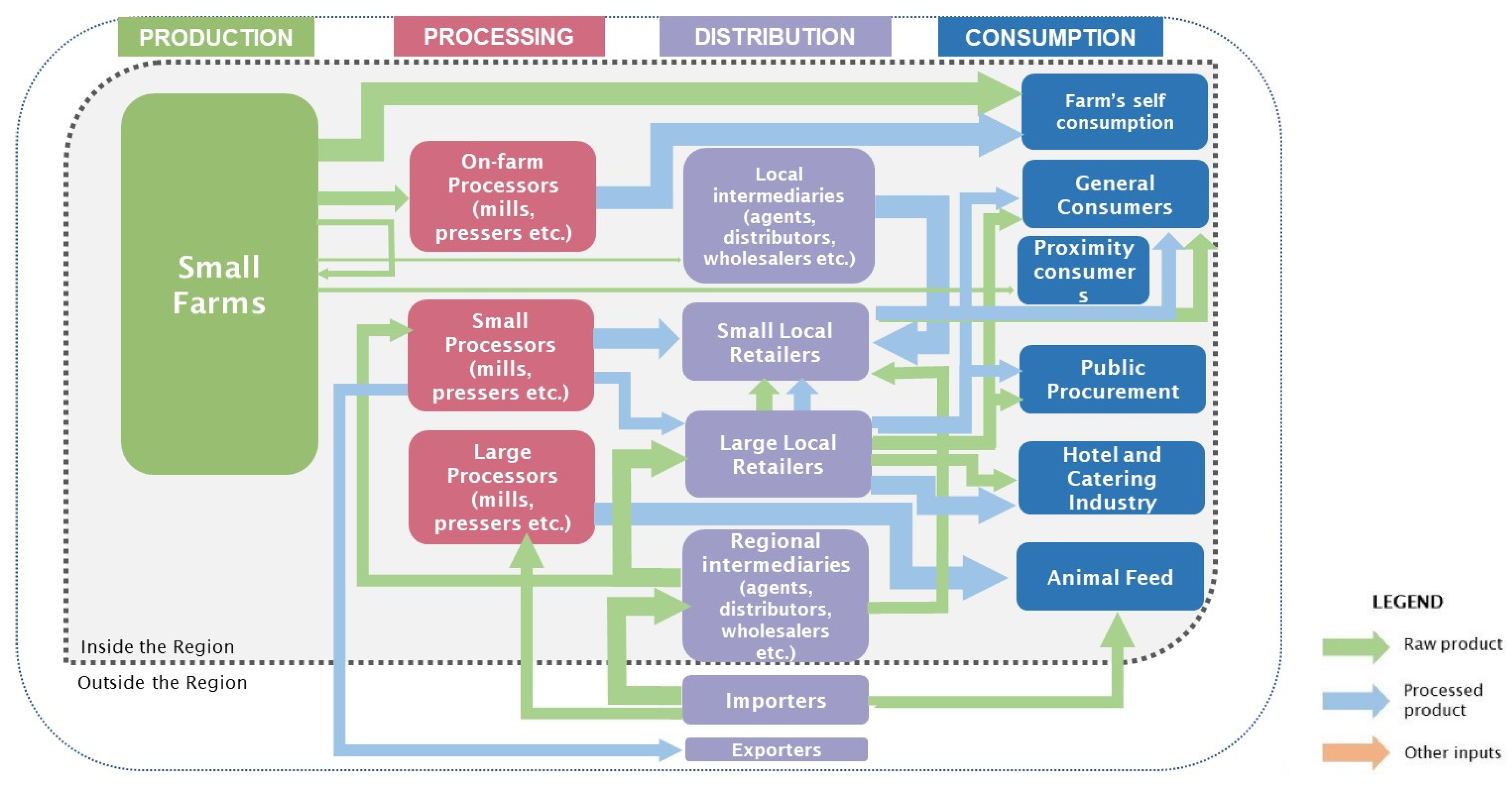
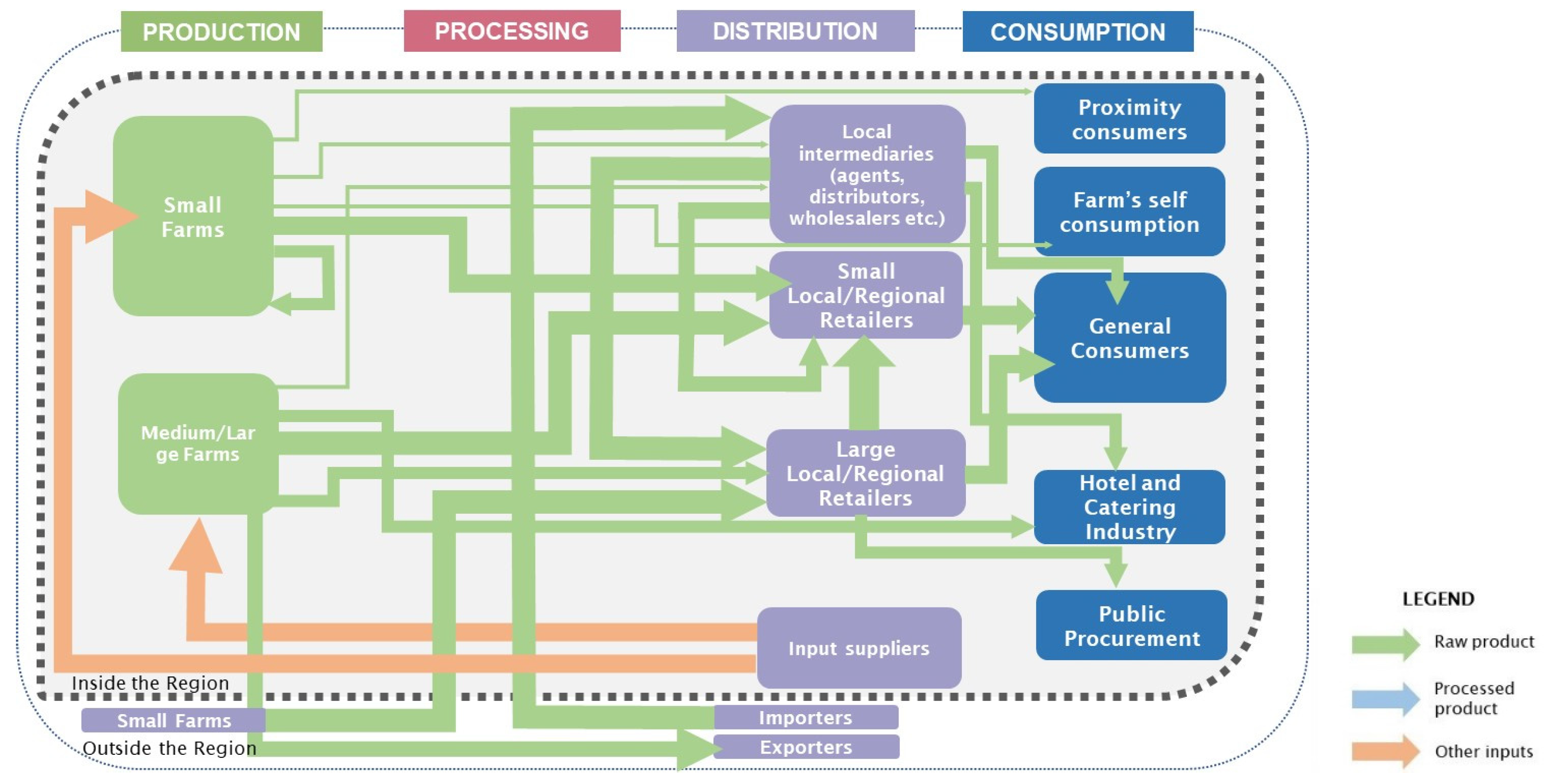
| Indicators | Data Santiago Region | Source |
|---|---|---|
| Land size (km2) | 991 | [28] |
| Population (thousands of people) | 313.431 | [27] |
| Density (people/km2) | 300 | [28] |
| GDP * (thousand USD/inhabitant) | 3.117 | [29] |
| Total number of holdings | 26.908 | [29] |
| Total agricultural area (ha) | 21.075 | [32] |
| Total utilized agricultural area (ha) | 18.719 | [32] |
| Agricultural area in mountain area (ha) | 1.809 | [46] |
| Average farm size (ha) | 1,13 | [32] |
| Number of farms by UAA** farm size (ha) | 0–5: 26.841; 5–20: 64; 20–50: 2; >50: 1 | [29] |
| Average size of farms < 5 ha of UAA (ha) | 0.5 | [32] |
| Area of main relevant crops (ha) | Maize: 19.027 Beans: 17.891 Vegetables: 650 Fruit Trees: 50 | [47] |
| Area of main relevant crops (ha) in farms <5 ha of UAA | Maize: 19.027 Beans: 17.891 Vegetables: 607 Fruit Trees: 28 | [47] |
| Livestock (LSU) per type | Bovine: 13.532 Goat: 121.886 Sheep: 7.108 Swine: 51.478 Chickens: 393.049 | [32] |
| Livestock (LSU) per type in farms <5 ha of UAA | Bovine: 12.824 Goat: 115.503 Sheep: 6.735 Swine: 48.782 Chickens: 372.467 | [32] |
| Annual work units (AWU) by UAA farm size (ha) | 0–5: 5.400; 5–20: 7.200; 20–50: 9.000; >50: 12.600 | [47] |
| Total family labour per farm size (ha) | 0–5: 107.364; 5–20: 275; 20–50: 8; m > 50: 4 | [32] |
| Category | [B] | [C] | [D] | [E] |
|---|---|---|---|---|
| Approximate Amount Produced in Region (ton/Year) | Approximate Amount Consumed in Region (ton/Year) | Balance (Consumed-Produced) [B-C] | % Surplus-Deficit on Total Consumption [D/C] | |
| Cereals | 3183,8 | 336921,8 | −333738 | −99% |
| Maize | 3183,8 | 96734 | −93550,2 | −97% |
| Rice | 0,0 | 14760,5 | −14760,5 | −100% |
| Oil plants | 0,0 | 5989,7 | −5989,7 | −100% |
| Olive | 0,0 | 373,8 | −373,8 | −100% |
| Rape and mustard | 0,0 | 3,3 | −3,3 | −100% |
| Palm | 0,0 | 42,9 | −42,9 | −100% |
| Vegetables | 31594,6 | 17969,2 | 13625,4 | 76% |
| Tomato | 6736,2 | 4551,8 | 2184 | 48% |
| Potato | 2067,2 | 8635,7 | −6569 | −76% |
| Sweet potato | 3279,8 | 2447,5 | 832 | 34% |
| Beans | 2808,5 | 1332,5 | 1476 | 111% |
| Onions | 3615,7 | 2245,3 | 1370 | 61% |
| Pepper | 2490,7 | 707,3 | 1783 | 252% |
| Cassava | 2989,1 | 2110,8 | 878 | 42% |
| Fruits | 10226,4 | 25755,8 | −15529,4 | −60% |
| Banana | 4504,2 | 3657,6 | 846,6 | 23% |
| Mangoes | 1191,7 | 4463,8 | −3272,1 | −73% |
| Papaya | 1456,4 | 4463,8 | −3007,4 | −67% |
| Apples | 0,00 | 1385 | −1385,00 | −100% |
| Grapes | 193,1 | 145,4 | 47,7 | 33% |
| Animal products | 8526,1 | 193468 | −184941,9 | −96% |
| Poultry meat | 444,9 | 4135,3 | −3690,4 | −89% |
| Pig meat | 2052,2 | 6003,4 | −3951,2 | −66% |
| Bovine meat | 370,1 | 741,1 | −371 | −50% |
| Eggs | 1124 | 1131,4 | −7,4 | −1% |
| Fish, Seafood | 4534,9 | 3607,3 | 927,6 | 26% |
© 2020 by the authors. Licensee MDPI, Basel, Switzerland. This article is an open access article distributed under the terms and conditions of the Creative Commons Attribution (CC BY) license (http://creativecommons.org/licenses/by/4.0/).
Share and Cite
Rodrigues Fortes, A.; Ferreira, V.; Barbosa Simões, E.; Baptista, I.; Grando, S.; Sequeira, E. Food Systems and Food Security: The Role of Small Farms and Small Food Businesses in Santiago Island, Cabo Verde. Agriculture 2020, 10, 216. https://doi.org/10.3390/agriculture10060216
Rodrigues Fortes A, Ferreira V, Barbosa Simões E, Baptista I, Grando S, Sequeira E. Food Systems and Food Security: The Role of Small Farms and Small Food Businesses in Santiago Island, Cabo Verde. Agriculture. 2020; 10(6):216. https://doi.org/10.3390/agriculture10060216
Chicago/Turabian StyleRodrigues Fortes, Arlindo, Vladmir Ferreira, Elsa Barbosa Simões, Isaurinda Baptista, Stefano Grando, and Erik Sequeira. 2020. "Food Systems and Food Security: The Role of Small Farms and Small Food Businesses in Santiago Island, Cabo Verde" Agriculture 10, no. 6: 216. https://doi.org/10.3390/agriculture10060216
APA StyleRodrigues Fortes, A., Ferreira, V., Barbosa Simões, E., Baptista, I., Grando, S., & Sequeira, E. (2020). Food Systems and Food Security: The Role of Small Farms and Small Food Businesses in Santiago Island, Cabo Verde. Agriculture, 10(6), 216. https://doi.org/10.3390/agriculture10060216







